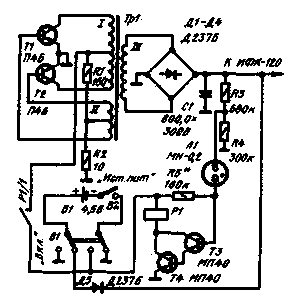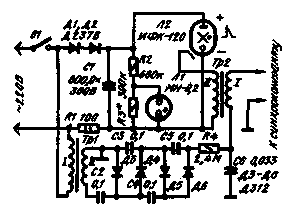
|
|
ENCYCLOPEDIA OF RADIO ELECTRONICS AND ELECTRICAL ENGINEERING Increasing the efficiency of flash lamps. Encyclopedia of radio electronics and electrical engineering
Encyclopedia of radio electronics and electrical engineering / Lighting Usually, to increase the efficiency of flash lamps, a disruption in the generation of the voltage converter of the power source is used at the moment the output voltage reaches a predetermined value. The main disadvantage of this method is that the converter transistors remain connected to the power source after the breakdown of the generated oscillations. The transistors are closed at this time, however, the presence of the initial collector current, which for powerful transistors used in the converter reaches several tens of milliamps, leads to unjustified energy consumption of the power source. So, for example, the initial collector current of P4B transistors can be equal to 20-40 mA. In a push-pull converter, the total current consumed in this case will be 40-80 mA, that is, with an interval between flashes of 30 minutes, 0,02-0,04 Ah is wasted, that is, almost 10% of the capacity of one 3336L battery. This disadvantage can be eliminated by assembling the converter according to the scheme shown in Fig. 1. Its peculiarity is that at a given level of output voltage, relay P1 disconnects the converter from the power source.
When switch B1 is set to the "On" position, the cascade, assembled on a composite transistor T3, T4, is supplied with a supply voltage and both transistors open. A current will flow through the relay winding P1, it will work and, through the contacts P1 / 1, will supply voltage to the converter, assembled on transistors T1 and T2. The storage capacitor C1 will begin to charge. When the voltage on it rises to about 300 V, the neon lamp L1 will light up and from the divider R3R4 the positive voltage through the lamp will go to the base of the transistor T3. Transistors T3 and T4 will turn off. The relay winding will be de-energized and the P111 contacts will disconnect the converter from the power source. As soon as the voltage across the capacitor C1 due to self-discharge drops to such a level that the L1 lamp goes out, the T4-T1 transistors will open again and the converter will start working again. The same thing will happen when the capacitor C4 is discharged during a flash. Thus, in the absence of generation in the described version of the converter, the current consumption from the power source is practically only the collector current of the transistor TXNUMX, which is fractions of a milliamp. Transistors TK and T4 in the device can be any low-frequency. Relay R1-RES-10 (RS4.524.304) or RSM-2 (10.171.81.58). Transformer Tr1 does not differ from those used in converters for flash lamps. In flash lamps, the converter operates on a very large capacitive load, as a result of which its mode at the moment of switching on turns out to be very stressful, the process of charging the storage capacitor is delayed, which leads to additional waste of energy from the power source. It is possible to significantly facilitate the operation of the converter at the initial moment and at the same time speed up the process of charging the capacitor. if you reduce its deforming by charging before turning on the converter to a certain voltage, for example, to the voltage of the power source. To ensure this mode, switch B1 (see Fig. 1) is set to the position indicated in the diagram. The power supply B1 is connected through the diode D5 to the storage capacitor C1. Diode D5 is designed to protect the power supply from the voltage of an incompletely discharged storage capacitor when the converter is turned off. AC powered flash lamps are much more economical. However, they have a drawback - the presence of mains voltage on the camera body and the danger of electric shock associated with this. This can be eliminated by isolating the camera body from the mains with an isolation transformer. In this case, the voltage to charge the storage capacitor is removed from the secondary winding of the transformer. The disadvantage of this method is that the transformer must be of considerable size due to high insulation requirements and is designed for a relatively large power, since it is necessary that the charging time of the storage capacitor is short and the charge is produced by a rather large current. This shortcoming can be avoided if the capacitor is charged directly from the network, and the ignition capacitor is charged through a transformer, thus separating the camera body and the network. A diagram of such a flash lamp is shown in Fig. 2. Transformer Tr1 in this case can be much smaller (any low-power step-down with a ratio of turns of the primary winding to the secondary 10:1). The rest of the parts and the Tr2 transformer are the usual ones used in flash lamps.
Author: V. Kovalev, Klimovsk, Moscow Region; Publication: N. Bolshakov, rf.atnn.ru
Machine for thinning flowers in gardens
02.05.2024 Advanced Infrared Microscope
02.05.2024 Air trap for insects
01.05.2024
▪ Closest pair of stars in binary system discovered ▪ Mitsubishi Automotive Projection Systems
▪ site section Field strength detectors. Article selection ▪ article No peace under the olives. Popular expression ▪ What do people get allergies from? Detailed answer ▪ article Compass points, angular markings. Travel Tips ▪ article Heat up the knitting needle. physical experiment
Home page | Library | Articles | Website map | Site Reviews www.diagram.com.ua |






 Arabic
Arabic Bengali
Bengali Chinese
Chinese English
English French
French German
German Hebrew
Hebrew Hindi
Hindi Italian
Italian Japanese
Japanese Korean
Korean Malay
Malay Polish
Polish Portuguese
Portuguese Spanish
Spanish Turkish
Turkish Ukrainian
Ukrainian Vietnamese
Vietnamese


 Leave your comment on this article:
Leave your comment on this article: